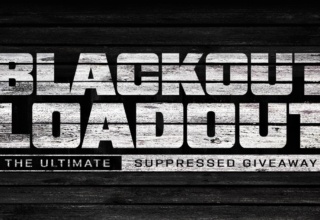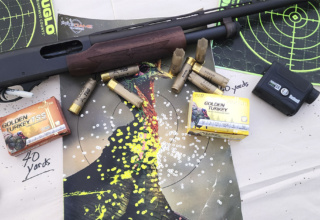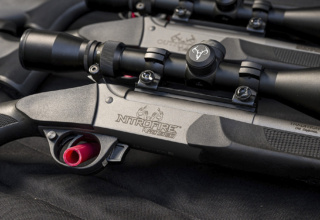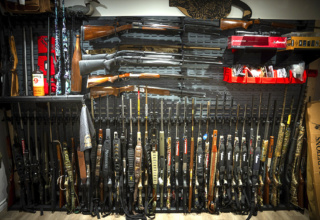The right gear combination can turn the tide when dueling with spring gobblers.
by Brad Fenson
The Turkey Track Club has been operating in the Black Hills of South Dakota for over three decades. Hunting the wild Merriam’s turkey in this rugged, beautiful part of its range is a ‘bucket list’ destination for many turkey aficionados. The pursuit of a wild bird, on public land, with substantial competition produces pride and passion for hunters and admiration for the gobbler.
We were anxious to hit the trails and explore the ridges lined with Ponderosa pines. My guide Tom Tremble has been hiking the turkey trails for over three decades, and I feel like he tested me the first day to see how far I could walk. It had been a strange spring, with late, heavy snows that forced birds back onto their wintering areas after they had dispersed for spring and breeding. The turkey population was on the move somewhere, but not where we were looking.
Early mornings and late nights became the norm. We hustled our tails off, trying to find a gobbler that would work our calls and decoys, but were frustrated us at every turn.
We stopped at a spot where we could shoot, as I wanted to check the shotgun. I was using a Browning Maxus 12 gauge dressed in Mossy Oak Bottomland. An Aimpoint Micro S-1 was mounted on the rib and was quickly dialed to center the tungsten pattern at 20 and 30 yards. The patterns are incredibly dense given the high pellet count of the small tungsten pellets.
Tungsten is 60 percent denser than lead. The payload with shot sizes 7 and 9 are remarkable. The ugly part of tungsten is that a heavy payload produces substantial recoil. Only requiring one shot to fill my turkey tag, I was not worried about the recoil. There are 20- and 410-gauge options for shooters who are recoil-shy but want the benefits of the tungsten loads.
We finally found a couple of strutters performing for a small flock of hens. It was not difficult to tell which bird was dominant, with its impressive tail fan and an attitude that let everything in the hills know he was boss. We watched the birds from a distance, knowing they had to move to where we could make a play on them. If we tried to approach, we knew we would get busted.
It took over an hour, but the last bird finally topped the ridge and disappeared. We headed out and made a big circle around an adjacent ridge to ensure we stayed hidden. Hens and gobblers sounded off in the distance, so we slithered up to the edge of a point to set up decoys and to try calling. The boss bird did not like the fact that competition was moving in from the hills and he gobbled back at us. It appeared the old boy was pushing his ladies farther up the draw, so we decided to belly-crawl over the lip of the rim to try and make the decoy more visible. Moving headfirst down the 90-degree slope, and belly-crawling with the shotgun in my hands, I froze when Tom whispered to stop.
Stuck in an awkward position, I was not sure I could even get the shotgun shouldered to shoot. A gobbler had snuck silently around the base of our ridge and was headed towards us. The ground was strewn with large boulders that had fallen from the eroding hillside. I saw a window of opportunity to swing my legs partway down the hill, allowing me to get the shotgun up. Seconds later, the gobbler rounded the last boulder less than 20 yards in front of me. The bird went from a half strut and started lifting its head like it sensed trouble. I steadied the Aimpoint on the bird where the red skin on its neck met feathers. At the report of the shotgun, the bird slammed to the ground and lay motionless. Tom yelled to get ready for a follow-up shot, as the bird was not flopping around, but the heavyweight tungsten load had knocked the wiggle out of the long old beard.
The Aimpoint sight proved its worth in Black Hills turkey. With the steep angle of the hill and my twisted body position, it was next to impossible to square up to the shotgun. Knowing that if I could see the red dot I would be on target gave me the peace of mind to pull the trigger and make a clean, killing shot.
The tungsten load put the gobbler to sleep instantly. Between the pellet count and the energy released in the bird, there was no flapping or worrying about the gobbler getting up. The best part about shooting the turkey was not feeling the recoil like I had when sighting the shotgun. Even holding the shotgun in an awkward position, the recoil was manageable, allowing for a direct head and neck shot.
Turkey Track Club
Turkey Track Club displays success and tally boards in the lodge for everyone to see the results from year to year. Date, weight, beard, spur length, and other details of the hunt are recorded. A certificate, photo, and an embroidered shoulder badge are presented to successful hunters as a memento of the unique hunt and as a symbol of club membership. The tradition is unique and fun. Turkey Track Club has achieved over 90% success rate and close to 2,000 Black Hills turkeys recorded in its books.
Browning TSS Tungsten Turkey
Browning’s TSS Tungsten Turkey gives hunters an edge for clean kills of wily turkeys. Loaded with dense tungsten shot — 60% denser than lead — it delivers energy and killing results long-range. The TSS is offered in duplex payloads of 7 and 9 shot, or straight 7s or 9s. Available in:
- 12-gauge 3 ½-inch 2 ¼ ounce loads of 7s or duplex 7 and 9
- 12-gauge 3-inch 1 ¾ ounce loads of 7s or duplex 7 and 9
- 20-gauge 3-inch 1 ¾ ounce loads of 7s or duplex 7 and 9
- 410-gauge 3-inch 13/16 ounce loads of 9s
Aimpoint Micro S-1
The Aimpoint Micro S-1 was explicitly designed for use on shotguns. The carbon-fiber reinforced mounting system positions the optic on the lowest possible optical axis and weighs next to nothing. The S-1 attaches to the shotgun at any point along the ventilated rib, and interchangeable adapter plates are included to accommodate most popular shotgun rib sizes. The bright 6 MOA red dot makes it easy to acquire the target quickly with accurate results. The dot does not have to be centered in the sight, and as long as you can see the entire dot, you are on target.






















